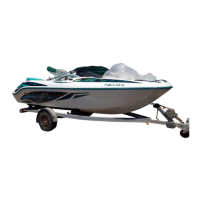Why does my Sea-doo Boat engine continually backfire?
- JJames LynnSep 9, 2025
If your Sea-doo Boat engine continually backfires, it may be due to weak spark, which is related to fouled or worn spark plugs.

Why does my Sea-doo Boat engine continually backfire?
If your Sea-doo Boat engine continually backfires, it may be due to weak spark, which is related to fouled or worn spark plugs.
Why am I getting a long beep on my Sea-doo Boat when using the safety lanyard?
A long beep when installing the safety lanyard on the DESS post or pressing the start/stop button on your Sea-doo Boat can indicate a bad connection between the safety lanyard cap and the DESS post. Try removing and reinstalling the safety lanyard on the DESS post; you should hear two short beeps, indicating the system is ready. It could also indicate that you are using the wrong safety lanyard; ensure you are using the lanyard programmed for the boat. If it doesn't work, contact an authorized dealer. Also, dried salt water or oil in the safety lanyard cap can cause this issue; clean the safety lanyard cap with dishwashing liquid.
What to do if I hear 4 short beeps on my Sea-doo Boat when starting?
Four short beeps when pressing the start/stop button with the safety lanyard already installed on your Sea-doo Boat indicates that the shifter is not in neutral. Place the shifter in neutral; you should hear one short beep when you reach the neutral position.
What does 2 short beeps mean on Sea-doo Sportster 1998 Boat?
If you hear two short beeps while installing the safety lanyard on the DESS post of your Sea-doo Boat, the engine can be started normally.
| Category | Boat |
|---|---|
| Manufacturer | Sea-Doo |
| Model | Sportster |
| Year | 1998 |
| Engine Type | 2-stroke |
| Engine | Rotax Marine Engine |
| Seating Capacity | 4 |
| Passenger Capacity | 4 |
Specifies the duration of warranty coverage for different parts of the jet boat.
Outlines Bombardier's responsibilities for repairing or replacing defective parts.
Steps the customer must take to ensure warranty service is performed.
Lists items and conditions that are not covered by the limited warranty.
Defines the extent of Bombardier's liability and disclaims other warranties.
Provides contact information and procedures for resolving warranty disputes.
Specifies the duration of warranty coverage for international markets.
Outlines Bombardier's responsibilities for international warranty repairs.
Steps for validating international warranty service.
Lists exclusions for the international warranty.
Defines liability limits for international warranty.
Provides international consumer assistance contacts.
Location of the Hull Identification Number (HIN) and model number.
Location of the Engine Identification Number (EIN).
Details on the safety lanyard, its installation, and operation.
Explanation of how the steering wheel controls boat direction and low-speed steering.
How to operate throttle levers to control engine speed and boat acceleration.
Operation of the 3-position shifter lever (forward, neutral, reverse).
Step-by-step instructions for safely fueling the jet boat.
Specifies the type of gasoline and octane rating required for the jet boat.
Specifies the type of oil for the injection system and alternatives.
Details the break-in period for the engine, including speed and load limitations.
Recommendation for a 10-hour service inspection by an authorized dealer.
Inspect hull for cracks or damage.
Inspect and clean jet pump water intake for obstructions.
Check steering for free movement and jet pump nozzle alignment.
Check throttle lever operation for free and smooth movement.
Explains how the jet propulsion system draws water and creates thrust.
How to steer the jet boat, including low-speed control and turning with throttle.
How steering response differs when operating in reverse.
Basic care steps after using the jet boat, including draining and wiping.
Special care required for operating in foul or salt water.
Flushing the cooling system and lubricating the engine for maintenance.
Steps to take if the engine overheats, including flushing and checking.
How to clean the jet pump intake and impeller to resolve clogging issues.
Instructions for towing the jet boat in the water, including precautions.
General lubrication points and important notes.
Procedure for lubricating the PTO flywheel(s).
Procedure for lubricating the ski post.
Lubricating carburetor springs, shafts, and oil injection pump.
Lubricating reverse gate pivoting points and mechanisms.
Lubricating the water intake grate and cable rod.
Procedure for replacing the bulb in the bow light assembly.
Procedure for replacing the bulb in the stern light.
Checks for engine compartment, battery, hoses, hull, and intake grate.
Procedures for cleaning the bilge, hull, and removing stains.
Refer to Trailer Owner's Guide for capacity and operation.
Precautions for towing the jet boat, including fuel valve and storage.
Ensuring weedless system lever is pushed in for loading/launching.
Recommendations for proper storage, including not running the engine.
Procedure for draining engine(s) to prevent freezing damage.
Using fuel stabilizer to prevent fuel deterioration and gumming.
Guide to interpreting beeper signals for troubleshooting engine and system issues.
Troubleshooting steps for when the engine fails to start or turns over slowly.
Troubleshooting steps for engine overheating issues.
Engine specifications including type, displacement, and lubrication.
Electrical system details including generator output, ignition, and fuses.
Table of base SI units and their symbols.
Factors for converting between different measurement units.
Procedure to follow and information to provide if the jet boat is stolen.